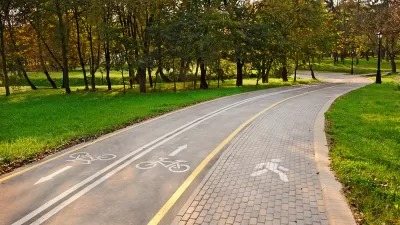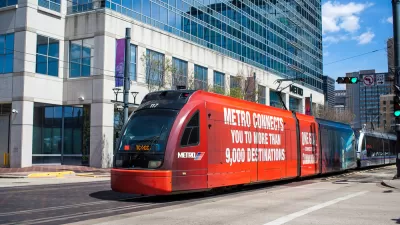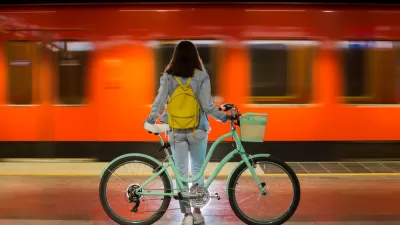The new Republican Party Platform wants to stop spending federal fuel tax funds on walking, cycling, and public transit. That would be unfair and inefficient.

An equitable and efficient transportation system must be diverse in order to serve diverse travel demands. Many local trips are best made by walking and cycling, public transit is often most efficient for passenger travel on major urban travel corridors, and automobiles are appropriate for some, but not all, travel. Accommodating these various types of travel reflects consumer sovereignty, the economic principle that markets should provide the goods and services that consumers want. Failing to do so deprives travellers of their preferred options, and because automobile travel is very resource intensive (it generally requires much more space for roads and parking, and more energy than other modes), it increases total costs.
Responding to these demands requires multi-modal transportation planning and funding, so communities can invest in the combination of facilities and services that best serve their needs. This can be challenging since conventional planning tends to favor automobile travel over other modes.
This is a timely issue. The new Republican Party Platform wants to dedicate federal fuel tax revenues strictly to highway projects and forbid expenditures on sidewalks, trails, ferry boats, scenic byways landscaping, historical renovations, or education initiatives. To their credit, the authors describe these as "worthwhile enterprises," but want them funded through other unspecified sources, which would put them at a disadvantage compared with highway projects, resulting in a less diverse, more automobile-dependent transportation system. Such funding restrictions contradict the concept of least cost planning, which chooses investments based on overall cost efficiency, considering all impacts, and so allows investments in alternative modes and demand management programs when they are a better alternative to roadway expansions.
Organizations such as the Reason Foundation and the American Trucking Association have long argued that fuel tax "diversions" are unfair and wasteful. Their arguments may seem justified from some perspectives, but they ignore key issues. A planner's job is to ensure that all perspectives are considered. Let's look at the arguments for and against multi-modal transportation funding.
Fairness
Argument
Horizontal equity requires "equal treatment of equals," which implies that people should "get what they pay for and pay for what they get." From this perspective, it seems unfair to spend motor vehicle user fees to subsidize other modes.
Counter-Arguments
If horizontal equity requires that motorists "get what they pay for," it also requires that they "pay for what they get." They don’t come close. Motor vehicle user fees pay only about half of total roadway expenses and only a tiny portion of non-residential parking, the rest is funded by general taxes or incorporated into rents, costs that people pay regardless of how much they drive. As a result, people who do not own a car tend to subsidize the roadway and parking facility costs of their vehicle-owning neighbors. Highway advocates are hypocritical when they demand that motor vehicle revenues be dedicated to roadways if they do not also advocate raising these fees to cover all road and parking facility costs.
Let's be specific. In 2012, all levels of government collected $142 billion in highway user taxes and fees, approximately $460 per capita, and spent a total of $221 billion on public roadways, approximately $710 per capita, indicating that residents pay approximately $250 annually in roadway subsidies. Parking expenditures and subsidies are even greater, averaging thousands of dollars annually per automobile (a typical urban parking space has $700-1,500 total annualized costs, and studies indicate that there are approximately three off-street parking spaces per motor vehicle in a typical city). It is only fair that people who rely on walking, cycling, and public transit receive their fair share of transportation spending.
Dedicating funding to highways is also regressive (vertically inequitable), because low-income people tend to rely on alternative modes more than their affluent neighbors. As a result, current transportation facility funding practices tend to force lower-income people to subsidize the roads and parking facilities used by motorists.
Motorists also have a moral obligation to provide sidewalks and paths to reduce the risks and barrier effect they impose on pedestrians and cyclists. If all motorists were cautious and willing to yield to pedestrians and cyclists whenever needed, special facilities would be unnecessary, but in practice, sidewalks and paths are necessary to avoid conflicts and reduce delays that motorists impose and bear. As a result, it is fair that motorists bear a portion of their costs.
Critics of multi-modal funding ignore other benefits that motorists receive from improvements to other modes. A more diversities transportation system reduces motorists' chauffeuring burdens. Although public transit serves only a small portion of total trips, it carries a major portion of travel on many congested urban corridors (for example, walking, cycling and public transit exceed 20% of commute trips in more than a dozen U.S. cities, and more than 45% of downtown Seattle commuters use public transit), and so provides significant traffic and parking congestion reductions. Even in Los Angeles, considered an automobile-oriented city, a transit strike increased highway congestion delay 47%. Many motorists also value having alternatives that they may use in the future if their vehicle is unavailable or they cannot drive, called option value.
Public transit also increases motorists' safety. Many traffic safety strategies, such as graduated licenses for young people, and anti-impaired driving campaigns, are intended to reduce high-risk driving. Their effectiveness depends on those groups having viable alternatives to driving. As a result, motorists have every reason to help financially walking cycling and public transit improvements that help reduce traffic problems.
Demand
Argument
Highway advocates often argue that since travel data indicate that because most trips are made by automobile, other modes are unimportant and deserve little investment.
Counter-Arguments
Commonly-used travel data sets tend to undercount walking, cycling, and public transit trips because they ignore short trips, travel by children, off-peak trips, non-commute trips, and walking links of multi-modal trips, such as when a motorist walks several blocks from a parked car to their destination. In most urban areas, 15-30% of trips are made by walking, cycling, and public transit, and this share often increases significantly after these modes are improved, indicating significant latent demand. For example, four typical U.S. communities participating in the Federal Highway Administration's Nonmotorized Transportation Pilot Program averaged 22.8% increases in walking trips and 48.3% bicycling trips, demonstrating that many residents want to walk and bike more than they currently do.
Demographic and economic trends, including aging population, changing consumer preferences, increasing urbanization, growing health and environmental concerns, are causing per capita automobile travel to peak and demand for alternative modes to grow. Good planning responds to these trends by shifting resources currently dedicated to automobile travel to improving alternatives. Just as IBM invested their typewriter sales profits into computer manufacturing facilities, it makes sense to invest current motor vehicle fee revenues to improve alternatives to prepare for the future. Failing to do so is backward, based on past demands, rather than the forward-thinking required to serve future demands.
Local Issue
Argument
Advocates of eliminating federal funding for walking, cycling, and public transit argue that those modes only serve local travel and so are not a federal issue.
Counter-Arguments
A major portion of urban highway traffic consists of local automobile trips, so federal dollars are being spent to serve local travel, and motorists on those facilities do benefit from improvements to alternative modes that reduce their chauffeuring burdens and traffic congestion, and therefore reduce federal highway traffic and costs. It therefore makes sense for the Federal Highway Administration to support alternative modes if they can save money overall.
Although the federal dollars contributes only minor portion (less than a quarter) of total roadway spending, it is provided as matching funds that leverage much larger spending. If federal funding can only be spent on highways, states and local governments will respond by favoring costly highway solutions that maximize their federal fund receipts. If federal funds are available for other modes, lower levels of government will invest in more diverse solutions.
Rational or Ideological?
Unfortunately, many people view this issue ideologically rather than rationally. Republican Party leaders seem to think that favoring automobile travel over other modes is a conservative goal. They are wrong. Ideological conservatives have every reason to support a diverse transportation system that responds to diverse travel demands, helps disadvantaged people help themselves, and solves transportation problems.
Our role as planners is often to say, "Yes, but..." and present alternative perspectives so decision makers, experts, and the general public can better understand policy issues. In this case, there are many reasons that public policies should support more rather than less federal investment in non-automobile modes.
What do you think? Are there other issues to consider when evaluating the value of transportation system diversity and how fuel tax revenues should be allocated?

Alabama: Trump Terminates Settlements for Black Communities Harmed By Raw Sewage
Trump deemed the landmark civil rights agreement “illegal DEI and environmental justice policy.”

Planetizen Federal Action Tracker
A weekly monitor of how Trump’s orders and actions are impacting planners and planning in America.

The 120 Year Old Tiny Home Villages That Sheltered San Francisco’s Earthquake Refugees
More than a century ago, San Francisco mobilized to house thousands of residents displaced by the 1906 earthquake. Could their strategy offer a model for the present?

Ken Jennings Launches Transit Web Series
The Jeopardy champ wants you to ride public transit.

BLM To Rescind Public Lands Rule
The change will downgrade conservation, once again putting federal land at risk for mining and other extractive uses.

Indy Neighborhood Group Builds Temporary Multi-Use Path
Community members, aided in part by funding from the city, repurposed a vehicle lane to create a protected bike and pedestrian path for the summer season.
Urban Design for Planners 1: Software Tools
This six-course series explores essential urban design concepts using open source software and equips planners with the tools they need to participate fully in the urban design process.
Planning for Universal Design
Learn the tools for implementing Universal Design in planning regulations.
Clanton & Associates, Inc.
Jessamine County Fiscal Court
Institute for Housing and Urban Development Studies (IHS)
City of Grandview
Harvard GSD Executive Education
Toledo-Lucas County Plan Commissions
Salt Lake City
NYU Wagner Graduate School of Public Service





























